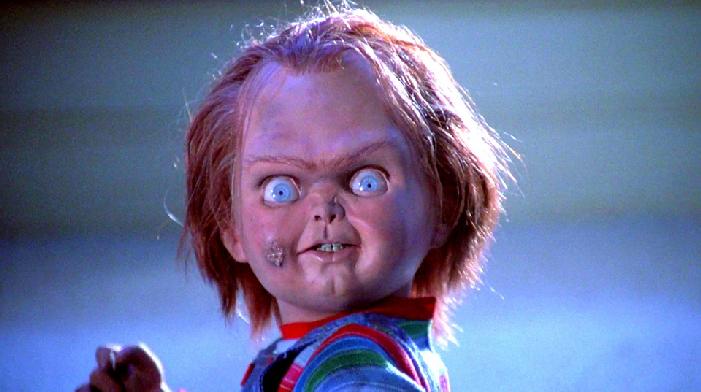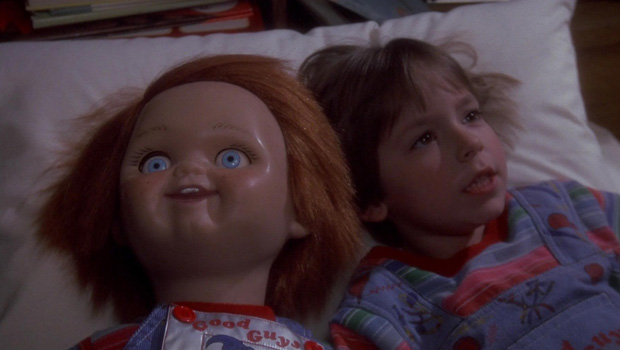Child’s Play (1988)
For the letter “C” I considered watching C.H.U.D. (which I’ve never seen) or Chopping Mall (which I’ve seen a hundred times), but as I thumbed through my horror DVDs I realized I haven’t watched the original Child’s Play in probably a decade and I was curious to see how the film stands up today.
For half a century, the horror genre was represented by a small handful of iconic characters: Dracula, Frankenstein, the Mummy, the Wolfman, and the Creature from the Black Lagoon. With the rise of the slasher genre, my generation’s four-pack of bad boys became Freddy Krueger, Jason Voorhees, Michael Myers, and the baddest doll of them all, Chucky from 1988’s Child’s Play.

Child’s Play opens with Detective Mike Norris in hot pursuit of two criminals, Eddie Caputo and Charles Lee Ray. After Caputo ditches his partner in crime, Ray and Norris duck into a nearby toy store while exchanging gunfire. Ray, mortally wounded in the exchange, quickly performs a black magic chant and transfers his soul into a nearby Good Guy doll, giving birth to both the film’s villain and an entire franchise.
Through somewhat questionable logic Chucky climbs back into his Good Guy packaging, ends up in a hobo’s shopping cart, and allows himself to be sold to one Karen Barclay. Karen unknowingly purchases the possessed doll as a birthday present for her six-year-old son, Andy.
Once inside the Barclay’s home Chucky wastes little time in driving a hammer into his first victim’s head, Karen’s friend (and Andy’s babysitter) Maggie. While Andy puts two and two together pretty quickly, he (logically) has a tough time convincing the adults around him (his mother and Detective Norris) that Chucky is alive.
The film briefly toys with the audience in making us think that Andy might possibly be the killer, but it’s abandoned pretty quickly as we begin to see Chucky walk and talk on his own. After disposing of Caputo (his former partner who abandoned him), Chucky is wounded in another altercation with Detective Norris. Chucky’s then visits his former Voodoo teacher, Dr. Death, who explains to him (and us) that his (Charles Lee Ray’s) soul will soon be stuck in the Chucky doll forever unless he can transfer his soul into the first person he revealed his true identity to. That, of course, turns out to be six-year-old Andy.
This is turning out to be one crappy birthday.
Like most horror villains, it turns out Chucky has a weakness; his heart. And I don’t mean emotionally, I mean literally, you have to shoot him in the heart. (If you just had a visual of a human heart and circulatory system somehow developing inside this plastic doll, you’re overthinking the film.) The visual of a burnt and partly dismembered Chucky fighting to the end* mirrors Sarah Connnor’s final showdown with the T-800 in 1984’s Terminator, and like that film, the protagonists here are forced to stop what appears to be an unstoppable force.
(*There are six movies in the franchise; Chucky’s “end” is somewhat relative.)
Prior to the release of the sequel, I couldn’t help but wonder what happened after this film ended. Maggie’s death has been ruled a homicide (she did take a hammer to the face), and two detectives will have to explain back at the station why they pumped a burnt up doll full of bullets inside an apartment building.
The film’s special effects are surprisingly good. The change is readily apparent each time Chucky changes from a puppet to a guy in a costume, but the doll as a practical effect works. While some part of this is due to the special effects crew, a big part is due to the wonderful voice work of Brad Dourif, who completely sells his performances, both as Charles Lee Ray and Chucky.
Like Freddy Krueger, somewhere along the way Chucky lost his edge and began delivering more snarky one-liners than stabbings in later sequels. In the beginning though, Chucky was downright evil although not particularly prolific in his killing. Child’s Play delivers a total of six deaths, two of which are Charles Lee Ray’s and Chucky’s!
While Child’s Play delivers a few jumpy moments, it’s hard to be scared by the film at this point. More scary, I think, is the thought of experiencing something with no rational explanation. In the film’s sequel we learn that that Karen Barclay ended up in a mental institution, and why shouldn’t she? Nobody will ever believe her story, despite the fact she knows it is true. It’s a life-changing and permanent paradigm-shifting event that would probably drive any of us mad.
(This review is a part of my month-long October 2014 A-Z Horror Reviews.)
